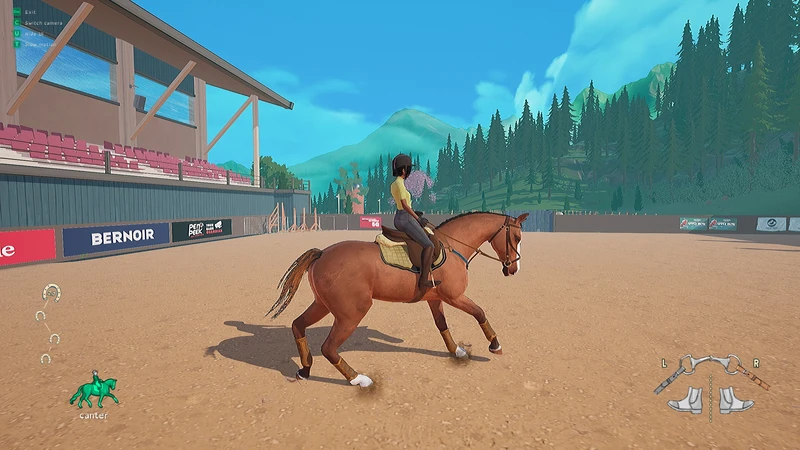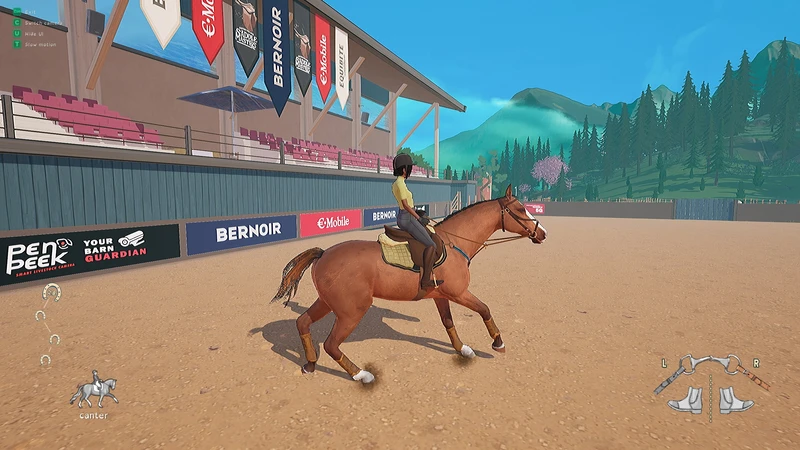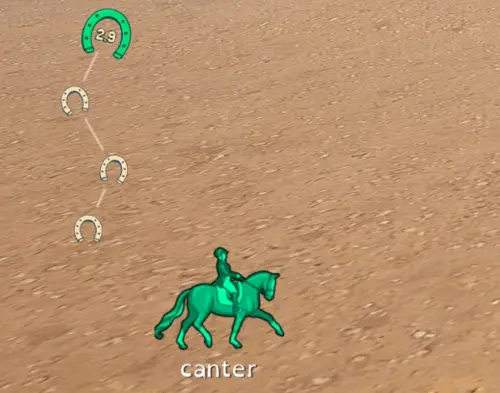Learn Dressage basics: riding on the bit, levels, and essential moves.
Tales of Rein Ravine: Dressage Guide
This guide summarizes key concepts from the in-game book Road to Grand Prix, covering Dressage basics like riding on the bit, levels, and essential moves. Future updates will introduce dressage lessons at Pinebelle Academy, so you won’t have to master everything on your own.
Riding on the Bit
The foundation for all dressage movements is for your horse to be “on the bit.” If your horse isn’t on the bit, dressage movements won’t be performed correctly, even if you give the appropriate aids. Riding on the bit means that you and your horse are in rhythm. Visually, the horse rounds its neck and lifts its ribcage and spine.
Rounded Canter (on the bit):

Hollow Canter:

During dressage, your horse should always be “on the bit.” This is especially important at higher dressage levels, where movements are more complex and are executed with minimal breaks between them. If your horse stops being on the bit, you won’t have time to recover. Therefore, riding on the bit is a fundamental concept that should be learned as early as possible when you begin your dressage journey.
Luckily, getting your horse on the bit is fairly simple. The rider needs to apply a half-halt in rhythm with the horse. Now, what does that mean? You simply need to slightly and quickly press the “S” key, in sync with your horse’s rhythm. The rhythm differs depending on the gait and speed. You can check your horse’s rhythm using the stride indicator on the left-hand side of the screen. When the horseshoe lights up green, it shows your horse’s rhythm. So to round your horse, simply apply a half-halt by quickly pressing “S” whenever the horseshoe lights up green.

If your aids are in rhythm, you will see the icon indicating your current gait turn green:

Continue performing half-halts to keep your horse on the bit. The frequency of the half-halts needed to maintain the form depends on the horse. However, if your horse is performing a movement, you don’t need to worry about keeping it on the bit.
In Summary:
- To perform dressage movements, your horse must be “on the bit.”
- You need to apply half-halts to get your horse on the bit.
- Half-halts are applied by quickly pressing the “S” key in sync with your horse’s rhythm.
- The rhythm is indicated when the horseshoe icon lights up green.
- Once your horse is fully rounded, you need to continue applying half-halts to maintain that form.
- The frequenzy of half-halts needed to maintain the form depends on the horse.
- During dressage movements, you don’t need to give half-halts.
Riding on the bit might be a bit difficult to get used to, but keep trying, and you will get the hang of it!
Level 1 – Novice
The focus of the Novice level is on riding the horse on the bit in all gates and riding some standard figures. It does not involve any complex dressage moves.
Required moves: walk-to-canter transitions
Required figures:
- serpentines
- tear drop
- circle
- across the long diagonal
Level 2 – Training
At Level 2, riding on the bit should not be a problem anymore, as it starts requiring multiple dressage moves.
Required moves:
- gait extension in walk and trot
- leg yield in walk
- singular flying change in canter
- riding curved paths in counter-canter
Level 3 – Intermediate
Required moves:
- leg yield in trot
- yield on a circle
- switching between right and left yield without break
- canter tempi changes on every third stride
Level 4 – Advanced
Required moves:
- piaffe
- leg yield in canter
- yielding in any gate along curved paths
- canter tempi changes on every other stride
Level 5 – Expert
Required moves:
- canter pirouette
- switch yielding directions in canter with a flying change
- canter tempi changes on every stride
This guide offers a concise overview of Dressage moves and levels from Road to Grand Prix, saving you time from searching through the book repeatedly. Since Tales of Rein Ravine is in Early Access, some controls may change in future updates.